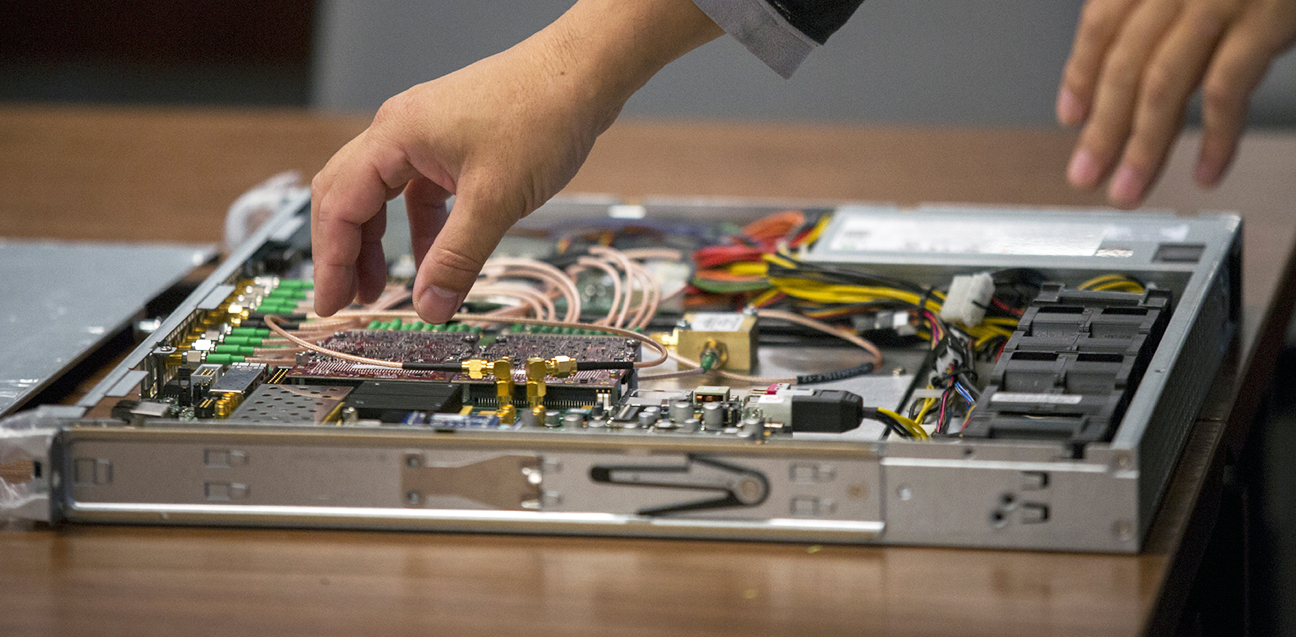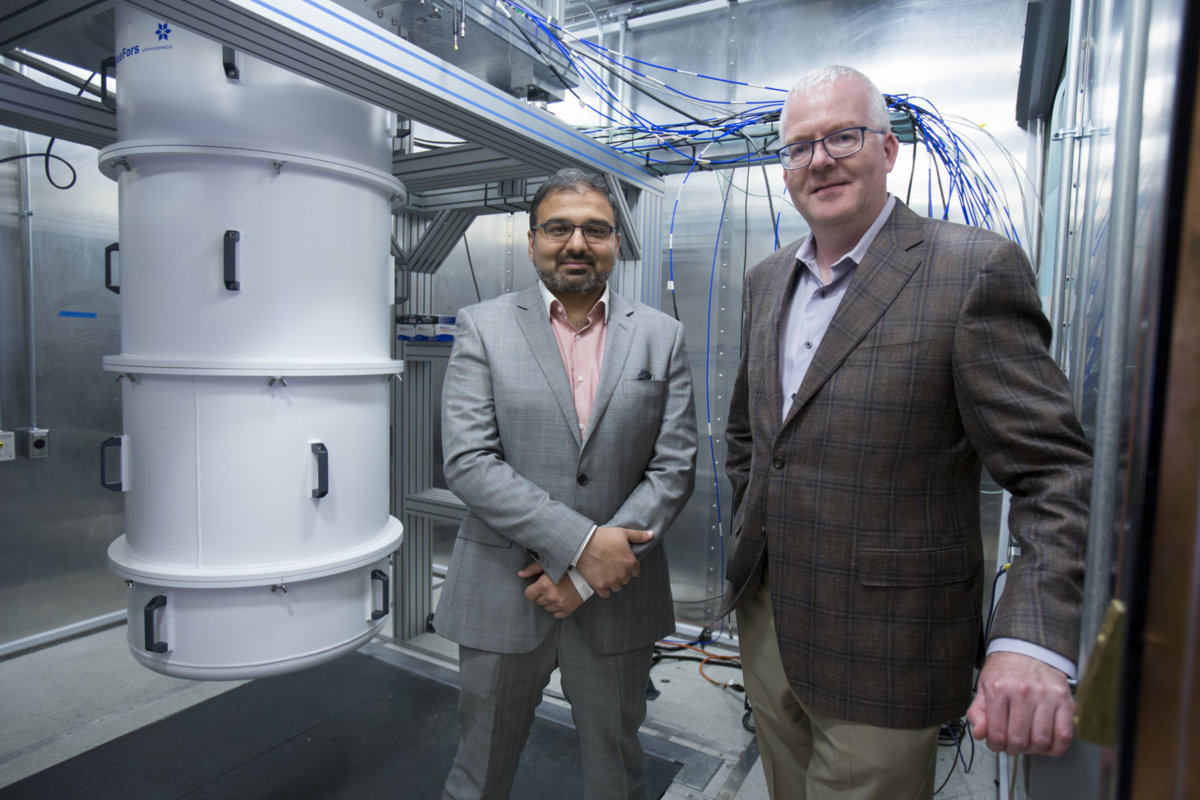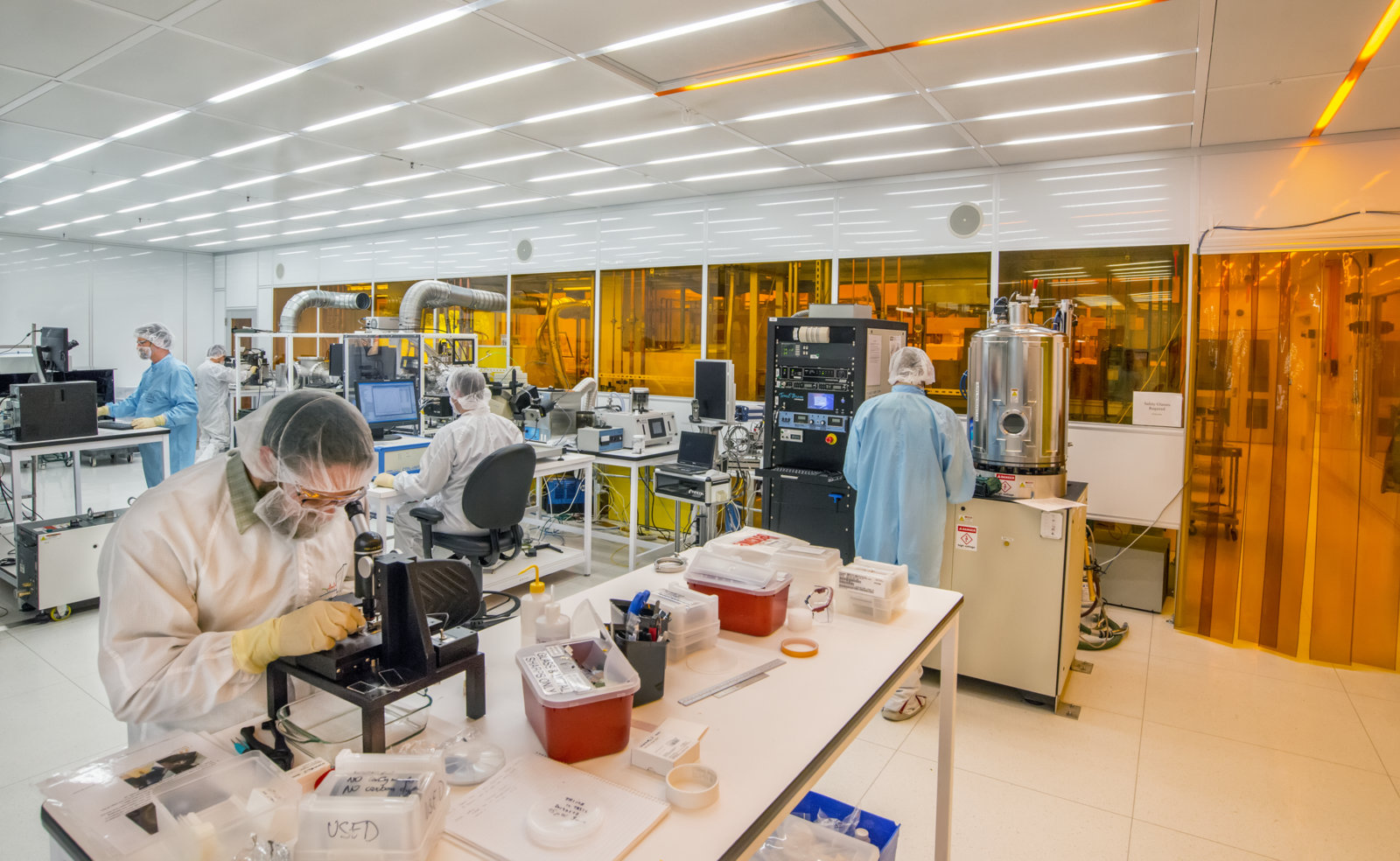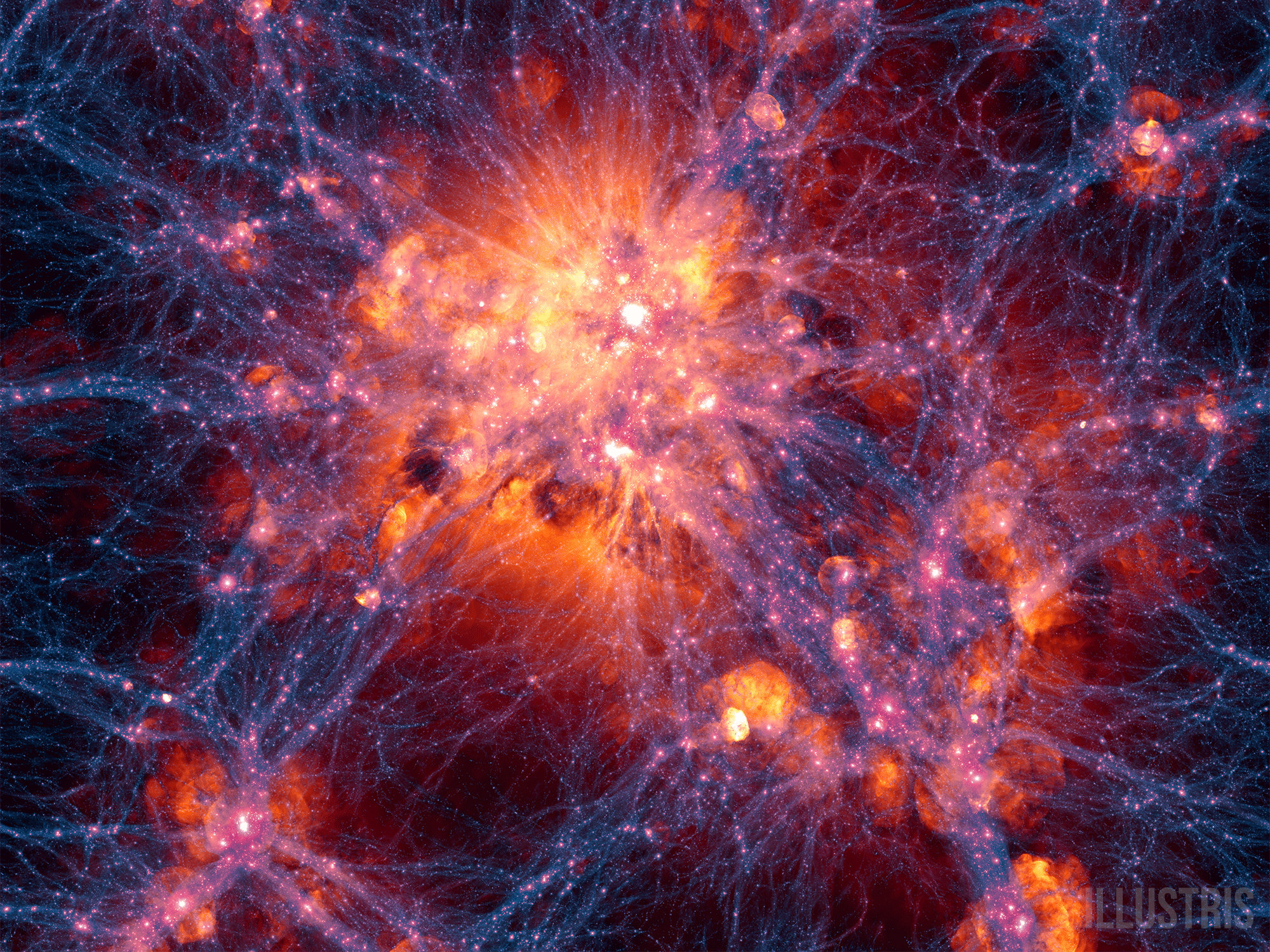
A new FPGA (field programmable gate array) module developed by Gang Huang, a research scientist in Berkeley Lab’s Accelerator Technologies and Applied Physics Division, and Larry Doolittle, a staff engineer in Berkeley Lab’s Engineering Division, for scalable control of superconducting qubits. (Credit: Peter DaSilva/Berkeley Lab)
Lawrence Berkeley National Laboratory (Berkeley Lab) this week announced support from the Department of Energy that significantly expands the Lab’s research efforts in quantum information science, an area of research that harnesses the phenomenon of quantum coherence, in which two or more particles are so tightly entangled that a change to one simultaneously affects the other. Quantum information science seeks to utilize this phenomenon to hold, transmit, and process information.
A series of DOE Office of Science awards, announced today, will enable Berkeley Lab to accelerate the development of quantum computing, which holds the promise of solving science problems that are far beyond the reach of today’s computers. The awards also further Berkeley Lab’s ability to optimize fabrication techniques for qubits (the fundamental units of quantum computing and sensing), improve quantum coherence in next-generation materials, create quantum-based sensors for discoveries in physics, and develop quantum computing algorithms for chemistry research.
The awards are the result of a long-standing commitment to quantum information science at Berkeley Lab, where the research area is a strategic initiative and strongly supported by Laboratory Directed Research and Development investment. In addition, Berkeley Lab and UC Berkeley have brought together researchers from several scientific disciplines to form Berkeley Quantum, a partnership that harnesses the expertise and facilities of both institutions to advance U.S. quantum information capabilities.
The new projects include:
Advanced Quantum Testbed

Irfan Siddiqi (left), director of the Lab’s AQT effort, and Jonathan Carter, AQT co-principal investigator, in front of a dilution refrigerator housing superconducting qubits. Siddiqi is a staff scientist in Berkeley Lab’s Material Sciences Division and Carter is the deputy of science for Berkeley Lab’s Computing Sciences Area. (Credit: Peter DaSilva/Berkeley Lab)
Berkeley Lab will receive $30 million over five years from the Office of Advanced Scientific Computing Research to build and operate an Advanced Quantum Testbed (AQT) for exploring superconducting quantum processors and evaluating how these emerging quantum devices can be utilized to advance scientific research. As part of this effort, Berkeley Lab will collaborate with MIT Lincoln Laboratory to deploy varied quantum processor architectures.
The project’s goal is to establish a multipartner scientific collaboration to build a platform that researchers can use to answer basic questions about quantum computing. The AQT will operate as an open resource for the community, allowing external researchers to evaluate superconducting architectures developed by testbed staff for simulations in chemistry, materials, and other areas of computation. The AQT will also address outstanding problems that impede the scalability of quantum computing devices. Industry can take the ideas developed at the testbed and transform them into commercial products.
The AQT is led by Irfan Siddiqi, a faculty scientist in Berkeley Lab’s Materials Sciences Division, and Jonathan Carter, deputy of science for Berkeley Lab’s Computing Sciences Area. Go here to read a more detailed news release on the AQT.
New Capabilities for Quantum Information Science at the Molecular Foundry

A nanofabrication clean room at Berkeley Lab’s Molecular Foundry. (Credit: Roy Kaltschmidt/Berkeley Lab)
The Molecular Foundry, a DOE Office of Science User Facility, received two awards from the Office of Basic Energy Sciences to develop research infrastructure to advance quantum information science.
In one project, Molecular Foundry scientists will create a “nanofabrication cluster toolset,” or an integrated suite of high-fidelity instruments that will allow users to investigate the fundamental limits of state-of-the-art quantum systems. The toolset will include a robotic fabrication system, a high-resolution electron beam writing system, and a low-temperature transport measurement system. Molecular Foundry users can purpose these tools to develop precision fabrication approaches that minimize sources of unwanted electrical, magnetic, and thermal “noise” in qubit circuits.
The second project will develop and integrate a unique suite of electron beam-based metrology techniques. The project combines spin-polarized low-energy electron microscopy (SPLEEM) with electron decoherence interferometry and cryogenic sample environments (down to temperatures of about 4 Kelvin). These tools will open powerful new research opportunities for Molecular Foundry users to explore electronic structures and spin textures in quantum materials, and solid-state structures relevant for quantum information science.
Highly Coherent Structures for Next-Generation Quantum Systems
An effort funded by the Office of Basic Energy Sciences will tackle unanswered questions associated with quantum coherence in thin-film materials. Increasing coherence lifetimes by up to 10 times in superconducting structures is critical to developing next-generation quantum systems, such as more advanced qubits, and would enable tests of quantum applications in computation and communication. Scientists in Berkeley Lab’s Materials Sciences Division will produce and validate the performance of functionalized quantum materials capable of supporting coherent phenomena approaching the millisecond timescale. The project is led by Irfan Siddiqi, who is also director of the Center for Quantum Coherent Science at UC Berkeley.
As part of the project, scientists will explore new ways to control decoherence in 3D structures for high-density information processing. Advanced imaging, spectroscopy, and noise-sensing techniques will permit characterization of structural disorder and dynamic fluctuations in metallic and dielectric layers, particularly at interfaces in quantum systems. The studies will be combined with new theoretical and computational tools to probe large-scale entanglement in quantum systems.
Quantum Sensor Development and Dark Matter Detection

A visualization of a massive galaxy cluster that shows dark matter density (purple filaments) overlaid with the gas velocity field. (Credit: Illustris Collaboration)
Through a new research program supported by the Office of High Energy Physics (HEP), a multidisciplinary team led by Maurice Garcia-Sciveres at Berkeley Lab will develop sensors that enlist the seemingly weird properties of quantum physics to probe for dark matter particles in new ways, with increased sensitivity and in previously unexplored energy regimes.
These quantum sensors will be used to look for very-low-mass dark matter particles – so-called “light dark matter” – by instrumenting two different detectors. One of these detectors will use liquid helium at a very low temperature where otherwise familiar phenomena such as heat and thermal conductivity display quantum behavior. The other detector will use specially fabricated crystals of gallium arsenide, also chilled to cryogenic temperatures.
Particle Physics, Computation, and Quantum Research Technologies
HEP will also support several other Berkeley Lab-involved research projects involving quantum information science. One effort will develop quantum algorithms and simulations for properties like information scrambling and error correction that are relevant to black hole theories, and to quantum computing involving highly connected arrays of superconducting qubits. UC Berkeley is heading up this research program, and Irfan Siddiqi is leading Berkeley Lab’s involvement.
Another effort will develop computer programs that test the interactions between fundamental particles in extreme detail, which could lead to a better way to understand particle events measured at CERN’s Large Hadron Collider, the world’s most powerful particle collider.
A third effort will develop and study the potential of quantum-based algorithms for pattern recognition to reconstruct charged particles. Increasingly powerful particle accelerators require vastly faster computer algorithms to monitor and sort through billions of particle events per second.
And an effort led by Fermi National Accelerator Laboratory will seek to image pairs of photons that exist in a state of quantum entanglement. This is the next step of a Berkeley Lab and Fermilab collaboration on the development of a detector for astrophysics experiments that can detect an individual unit of light. This Skipper-CCD detector was successfully demonstrated in the summer of 2017.
Siddiqi is also leading a separate research program, Field Programmable Gate Array-Based Quantum Control for High-Energy Physics Simulations With Qutrits, that will develop specialized tools and logic families for high-energy-physics-focused quantum computing. This effort involves Berkeley Lab’s Accelerator Technology and Applied Physics Division.
Go here to read a more detailed news release on all of Berkeley Lab’s new QIS-related HEP projects.
Quantum Computing Algorithms for Chemistry
Another project will combine the power of conventional computing and quantum hardware to tackle complex chemistry topics such as catalysis, photocatalysis, actinide chemistry, and related fields. Bert de Jong, a scientist in Berkeley Lab’s Computational Research Division, is a co-principal investigator on the project, which is led by Pacific Northwest National Laboratory and funded by the Office of Basic Energy Sciences.
The project will embed quantum hardware in a conventional computational chemistry framework. Through this effort, algorithms that will benefit from quantum hardware can be deployed on quantum coprocessors while the bulk of the program logic remains on conventional computer architecture. Quantum processors have a hardware advantage over conventional processors in simulating strongly interacting quantum systems, and have the potential to more accurately capture complex chemical transformations.
In addition, Quantum Algorithms for Chemical Sciences, which is led by de Jong, will continue to develop novel algorithms, compiling techniques, and scheduling tools that will enable near-term quantum computing platforms to be used for scientific discovery in the chemical sciences and beyond. This project is funded by the Office of Advanced Scientific Computing Research.
Quantum Materials
The “quantum ecosystem” at Berkeley Lab was also recently enhanced through the Center for Novel Pathways to Quantum Coherence in Materials, a Berkeley Lab-led DOE Energy Frontier Research Center (EFRC) that was announced in June, in which Argonne National Laboratory, Columbia University, and UC Santa Barbara are also major partners. The new EFRC, which is led through Berkeley Lab’s Materials Sciences Division and draws on expertise and instrumentation at the Advanced Light Source and Molecular Foundry (both DOE Office of Science User Facilities), will contribute to understanding how the properties of important electronic and optical materials are related to underlying quantum coherence phenomena, which can be harnessed for quantum information processing. It will also advance capabilities such as ultrasensitive quantum measurements of electric and magnetic fields.
More info:
- Department of Energy Announces $218 Million for Quantum Information Science
- A Quantum Leap Toward Expanding the Search for Dark Matter
- Berkeley Lab to Build an Advanced Quantum Computing Testbed
- About Berkeley Quantum
###
Lawrence Berkeley National Laboratory addresses the world’s most urgent scientific challenges by advancing sustainable energy, protecting human health, creating new materials, and revealing the origin and fate of the universe. Founded in 1931, Berkeley Lab’s scientific expertise has been recognized with 13 Nobel Prizes. The University of California manages Berkeley Lab for the U.S. Department of Energy’s Office of Science. For more, visit http://www.lbl.gov.
DOE’s Office of Science is the single largest supporter of basic research in the physical sciences in the United States, and is working to address some of the most pressing challenges of our time. For more information, please visit the Office of Science website at science.energy.gov.